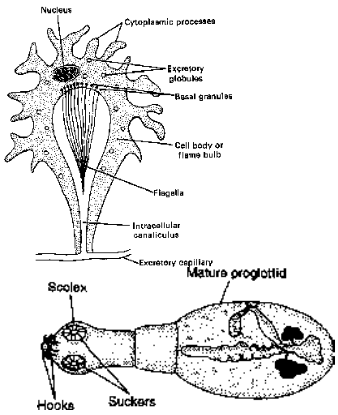Important Points to Remember
Classification of Animals Non Chordates of Class 11
- Vitelline glands or yolk glands secrete yolk cells.
- Fasciola is harmless to snail but it is pathogenic in vertebrate hosts including man. It causes “liver rot”.
- Cysticercosis is caused by incidental ingestion of onchospheres. These may settle in eye causing blindness, in case in brain, causes necrosis which may result in epilepsy, paralysis or death.
- Syncytial means when cell boundaries are not demarcated by cell membrane. Several nuclei live in the cytoplasm.
- Stomadaeum is anterior part of alimentary canal lined with epidermis.
- Proctodaeum is the last part of alimentary canal & is lined with epidermis.
- Fasciola gigantica is liver fluke of cattle.
- Fasciolopis (Fasciola buski) is a fluke that lives in human stomach & duodenum. It causes liver rot.
- The term heterogamy is used when larval forms reproduce asexually by parthenogenesis.
- Therapy means treatment of diseases.
- Prophylaxis means, prevention of infection of the disease by germs.
- Planaria has lateral polarity. If head is cut longitudinally into two or several parts along middle line, each part grows into a complete head thus forming a several headed planaria. This is heteromorphosis.
- Laurer’s canal is a muscular copulatory organ which serves as vagina during copulation.
- Mehlis glands or shell glands do not play any role in shell formation. Their secretion helps to lubricate the uterus for the smooth passage of eggs.

Fig. A flame cell Fig. Echinococcus granulosus : Dog tapeworm
Further Reading :
1. Protozoa
2. Plasmodium
3. Polychaeta
4. Oligochaeta
- Introduction
- Fundamentals of Animal Classification
- Body Plan and Symmetry
- Metamerism and Germ Layers
- Body Cavity or Coelom
- Protostomes And Deuterostomes
- Modern Classification of Animal World
- Five Kingdoms of Living World
- Kingdom Protista
- Protozoa
- Plasmodium
- Some Representatives of Phylum Protozoa
- Paramecium
- Phylum Porifera
- Canal System and Skeleton
- Some representatives of phylum - Porifera
- Cnidaria (Gr. Knide = nettle or stringing cell)
- Some representatives of phylum Coelentrata
- Phylum Platyhelminthes - The flat worms
- General Topics (Dugesia, Schistosoma, fasciola, Taneia solium)
- Important Points to Remember
- Phylum Aschelminthes
- Some representatives of Nematoda
- Phylum Annelida
- Polychaeta
- Oligochaeta
- Hirudinea
- Phylum Arthoropoda
- General Topics
- Important Points to Remember of Chelicerae
- Phylum Mollusca
- General Topics of Phylum Mollusca
- Important Points to Remember of Phylum Mollusca
- Phylum Echinodermata
- General Topics of Phylum Echinodermata
- Important Points to Remember of Phylum Echinodermata
- Exercise 1
- Exercise 2
- Exercise 3
- Exercise 4
- Exercise 5
- Exercise 6









